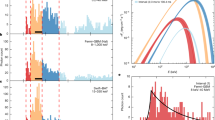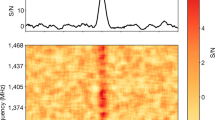Abstract
Mergers of neutron-star/neutron-star binaries are strong sources of gravitational waves1,2,3. They can also launch subrelativistic and mildly relativistic outflows4,5,6,7,8 and are often assumed to be the sources of short γ-ray bursts9. An electromagnetic signature that persisted for weeks to months after the event would strengthen any future claim of a detection of gravitational waves10. Here we present results of calculations showing that the interaction of mildly relativistic outflows with the surrounding medium produces radio flares with peak emission at 1.4 gigahertz that persist at detectable (submillijansky) levels for weeks, out to a redshift of 0.1. Slower subrelativistic outflows produce flares detectable for years at 150 megahertz, as well as at 1.4 gigahertz, from slightly shorter distances. The radio transient RT 19870422 (ref. 11) has the properties predicted by our model, and its most probable origin is the merger of a compact neutron-star/neutron-star binary. The lack of radio detections usually associated with short γ-ray bursts does not constrain the radio transients that we discuss here (from mildly relativistic and subrelativistic outflows) because short γ-ray burst redshifts are typically >0.1 and the appropriate timescales (longer than weeks) have not been sampled.
This is a preview of subscription content, access via your institution
Access options
Subscribe to this journal
Receive 51 print issues and online access
$199.00 per year
only $3.90 per issue
Buy this article
- Purchase on Springer Link
- Instant access to full article PDF
Prices may be subject to local taxes which are calculated during checkout
Similar content being viewed by others
References
Taylor, J. H. & Weisberg, J. M. A new test of general relativity — gravitational radiation and the binary pulsar PSR 1913+16. Astrophys. J. 253, 908–920 (1982)
Esposito, L. W. & Harrison, E. R. Properties of the Hulse-Taylor binary pulsar system. Astrophys. J. 196, L1–L2 (1975)
Wagoner, R. V. Test for the existence of gravitational radiation. Astrophys. J. 196, L63–L65 (1975)
Rosswog, S., Davies, M. B., Thielemann, F. & Piran, T. Merging neutron stars: asymmetric systems. Astron. Astrophys. 360, 171–184 (2000)
Ruffert, M. & Janka, H. Coalescing neutron stars — a step towards physical models. III. Improved numerics and different neutron star masses and spins. Astron. Astrophys. 380, 544–577 (2001)
Yamamoto, T., Shibata, M. & Taniguchi, K. Simulating coalescing compact binaries by a new code (SACRA). Phys. Rev. D. 78, 064054 (2008)
Rezzolla, L., Baiotti, L., Giacomazzo, B., Link, D. & Font, J. A. Accurate evolutions of unequal-mass neutron-star binaries: properties of the torus and short GRB engines. Class. Quantum Grav. 27, 114105 (2010)
Kiuchi, K., Sekiguchi, Y., Shibata, M. & Taniguchi, K. Exploring binary-neutron-star-merger scenario of short-gamma-ray bursts by gravitational-wave observation. Phys. Rev. Lett. 104, 141101 (2010)
Eichler, D., Livio, M., Piran, T. & Schramm, D. N. Nucleosynthesis, neutrino bursts and gamma-rays from coalescing neutron stars. Nature 340, 126–128 (1989)
Kochanek, C. S. & Piran, T. Gravitational waves and gamma-ray bursts. Astrophys. J. 417, L17–L20 (1993)
Bower, G. C. et al. Submillijansky transients in archival radio observations. Astrophys. J. 666, 346–360 (2007)
Smith, J. R. LIGO Scientific Collaboration.. The path to the enhanced and advanced LIGO gravitational-wave detectors. Class. Quantum Grav. 26, 114013 (2009)
Li, L. & Paczyn´ski, B. Transient events from neutron star mergers. Astrophys. J. 507, L59–L62 (1998)
Metzger, B. D. et al. Electromagnetic counterparts of compact object mergers powered by the radioactive decay of r-process nuclei. Mon. Not. R. Astron. Soc. 406, 2650–2662 (2010)
Hansen, B. M. S. & Lyutikov, M. Radio and X-ray signatures of merging neutron stars. Mon. Not. R. Astron. Soc. 322, 695–701 (2001)
Moortgat, J. & Kuijpers, J. Gravitational waves in magnetized relativistic plasmas. Phys. Rev. D 70, 023001 (2004)
Pshirkov, M. S. & Postnov, K. A. Radio precursors to neutron star binary mergings. Astrophys. Space Sci. 330, 13–18 (2010)
Rosswog, S. Mergers of neutron star-black hole binaries with small mass ratios: nucleosynthesis, gamma-ray bursts, and electromagnetic transients. Astrophys. J. 634, 1202–1213 (2005)
Levinson, A. General relativistic, neutrino-assisted magnetohydrodynamic winds-theory and application to gamma-ray bursts. I. Schwarzschild geometry. Astrophys. J. 648, 510–522 (2006)
Metzger, B. D., Piro, A. L. & Quataert, E. Time-dependent models of accretion discs formed from compact object mergers. Mon. Not. R. Astron. Soc. 390, 781–797 (2008)
Dessart, L., Ott, C. D., Burrows, A., Rosswog, S. & Livne, E. Neutrino signatures and the neutrino-driven wind in binary neutron star mergers. Astrophys. J. 690, 1681–1705 (2009)
Chevalier, R. A. Synchrotron self-absorption in radio supernovae. Astrophys. J. 499, 810–819 (1998)
Chevalier, R. A. & Fransson, C. Circumstellar emission from Type Ib and Ic supernovae. Astrophys. J. 651, 381–391 (2006)
Frail, D. A., Waxman, E. & Kulkarni, S. R. A 450 day light curve of the radio afterglow of GRB 970508: fireball calorimetry. Astrophys. J. 537, 191–204 (2000)
Frail, D. A. et al. Accurate calorimetry of GRB 030329. Astrophys. J. 619, 994–998 (2005)
Rhoads, J. E. How to tell a jet from a balloon: a proposed test for beaming in gamma-ray bursts. Astrophys. J. 487, L1–L4 (1997)
Soderberg, A. M. & Frail, D. A. GRB060313: radio observations. GCN Circ. 4884, (2006)
van der Horst, A. J. GRB 060801: WSRT radio observations. GCN Circ. 5390, (2006)
Wieringa, M. H., Chandra, P. & Frail, D. A. ATCA radio observations of short hard burst GRB 071112B. GCN Circ. 7095, (2007)
Wen, L. & Chen, Y. Geometrical expression for the angular resolution of a network of gravitational-wave detectors. Phys. Rev. D 81, 082001 (2010)
Acknowledgements
We thank D. Frail, S. Kulkarni, A. Levinson, A. MacFadyen, E. Ofek and S. Rosswog for discussions. This research was supported by an ERC advanced research grant, by the Israeli Center for Excellence for High Energy Astrophysics, by the ISF (grant No. 174/08) and by an IRG grant.
Author information
Authors and Affiliations
Contributions
Both authors contributed equally.
Corresponding authors
Ethics declarations
Competing interests
The authors declare no competing financial interests.
Supplementary information
Supplementary Information
This file contains Supplementary Text and Data 1-3 and additional references. (PDF 135 kb)
Rights and permissions
About this article
Cite this article
Nakar, E., Piran, T. Detectable radio flares following gravitational waves from mergers of binary neutron stars. Nature 478, 82–84 (2011). https://doi.org/10.1038/nature10365
Received:
Accepted:
Published:
Issue Date:
DOI: https://doi.org/10.1038/nature10365
This article is cited by
-
Strange flashes linked to stars merging rather than dying
Nature (2022)
-
Gravitational waves and electromagnetic transients
Journal of Astrophysics and Astronomy (2022)
-
Modeling the late-time merger ejecta emission in short gamma ray bursts
Journal of Astrophysics and Astronomy (2022)
-
Athena synergies in the multi-messenger and transient universe
Experimental Astronomy (2022)
-
Coalescence of black hole–neutron star binaries
Living Reviews in Relativity (2021)
Comments
By submitting a comment you agree to abide by our Terms and Community Guidelines. If you find something abusive or that does not comply with our terms or guidelines please flag it as inappropriate.



